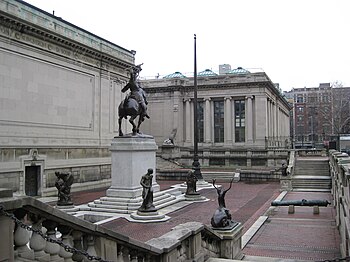Audubon Terrace
|
Audubon Terrace Historic District
|
|

(2008)
|
|
| Location | Between Broadway & Riverside Drive, between West 155th & 156th Streets Manhattan, New York City |
|---|---|
| Coordinates | 40°50′0″N 73°56′49″W / 40.83333°N 73.94694°WCoordinates: 40°50′0″N 73°56′49″W / 40.83333°N 73.94694°W |
| Built | 1907 |
| Architect | Charles Pratt Huntington |
| Architectural style | Beaux Arts/American Renaissance |
| NRHP Reference # | 80002667 |
| Significant dates | |
| Added to NRHP | May 30, 1980 |
| Designated NYCL | January 9, 1979 |
Audubon Terrace, also known as the Audubon Terrace Historic District, is a landmark complex of eight early-20th century Beaux Arts/American Renaissance buildings located on the west side of Broadway, bounded by West 155th and West 156th Streets, in the Washington Heights neighborhood of upper Manhattan, New York City. Home to several cultural institutions, the architecturally complementary buildings, which take up most of a city block, are arranged in two parallel rows facing each other across a common plaza. The complex is directly across 155th Street from Trinity Church Cemetery.
Although the 157th Street subway station on the 1 train is one block away, the complex's location considerably north of midtown has resulted in a perceived detriment to easy access for visitors, especially those from out of town. The complex was designated a New York City landmark in 1979, and was added to the National Register of Historic Places in 1980.
Named for naturalist and artist John James Audubon, on whose former land the complex sits, Audubon Terrace was commissioned in 1907 by Archer M. Huntington, the heir to the Southern Pacific Railroad fortune, a philanthropist and a Spanish scholar. The master plan for the site was drawn up by his cousin, architect Charles P. Huntington, in 1908. Archer Huntington chose the location at a time when the two centuries old northward march of fashionable residences and cultural institutions seemed likely to transform the largely rural area. He assumed that other museums and learned societies would soon join him, creating an intellectual citadel atop the island's heights. The widespread adoption of the elevator and steel framing at this time, however, led Manhattan real estate to begin to develop vertically instead and New York's other great cultural institutions failed to follow suit - in fact, most of the organizations which located on Audubon Terrace were headed by or strongly connected to Huntington.
...
Wikipedia



